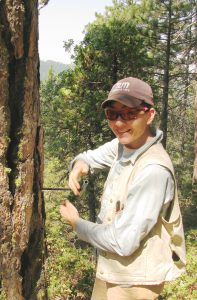 I am an ecosystem ecologist interested in understanding how and why forests change. In particular, I observe patterns of growth and mortality in trees to reveal how ecosystems respond to human demands and disturbances. I am a postdoctoral researcher collaborating with Matthew Potts’ Research Group and the U.S. Forest Service Pacific Northwest Research Station. My work focuses on the causes and consequences of tree mortality in California’s forests, and leverages the comprehensive surveys conducted by the USFS Forest Inventory and Analysis Program across the nation.
I am an ecosystem ecologist interested in understanding how and why forests change. In particular, I observe patterns of growth and mortality in trees to reveal how ecosystems respond to human demands and disturbances. I am a postdoctoral researcher collaborating with Matthew Potts’ Research Group and the U.S. Forest Service Pacific Northwest Research Station. My work focuses on the causes and consequences of tree mortality in California’s forests, and leverages the comprehensive surveys conducted by the USFS Forest Inventory and Analysis Program across the nation.
I completed my PhD research at UC Berkeley in 2016, working with Professor John Battles and the fabulous Forest Community Ecology research group. My projects investigated the ecosystem impacts of air pollution and climate on Sierra Nevada forests, including how ozone and drought interact to impact long term growth, and how these impacts vary across natural and anthropogenic landscapes. In related work, I led a study examining how standing dead trees contribute to carbon dynamics in California mixed conifer forests. I am continuing to pursue these research interests, along with collaborations on drinking water protection for global cities (at SESYNC), environmental education for educators (with the Forestry Institute for Teachers ) and other investigations into our natural world.
Recent Publications:
Huber-Stearns, H., Bennett, D., Posner, S., Richards, R., Hoyle, J., Cousins, S., and Romulo, C. 2017. Social-Ecological Enabling Conditions for Environmental Policies: A Review of Current Conversations. Ecology and Society 22: 1:18. DOI:10.5751/ES-08979-220118
Cousins, S., Battles, J., Sanders, J., and York, R. 2015. Decay patterns and carbon dynamics of standing dead trees in mixed conifer forests. Forest Ecology and Management 353: 136-147. DOI: 10.1016/j.foreco.2015.05.030
Battles, J., and Cousins, S. University of California Berkeley. 2015. Carbon Dynamics and Greenhouse Gas Emissions of Standing Dead Trees In California Mixed Conifer Forests. California Energy Commission. Publication number: CEC-500-2016-001. http://www.energy.ca.gov/2016publications/CEC-500-2016-001/CEC-500-2016-001.pdf
Battles, J. Saah, D., Robards, T., Cousins, S., York, R., and Larson, D., 2013. Intact Forests. Sequoia and Kings Canyon National Parks Natural Resource Condition Assessment. Appendix 12 in: Panek, J.A., J.J. Battles, J.T. Austin, C.A. Sydoriak, K.R. Nydick, A.M. Esperanza, D.S. Saah. 2013. A natural resource condition assessment for Sequoia and Kings Canyon National Parks. Natural Resource Report NPS/SEKI/NRR—2013/665.12. National Park Service, Fort Collins, Colorado. https://irma.nps.gov/DataStore/Reference/Profile/2195490
Cousins, S., and DuVal, A. 2012. Management Approaches for Protected Areas of Cultural and Biological significance: the Beech Pollards of Aiako Harria Natural Park. Chapter 5 in: Integrative Protected Area Management: Reconciling conservation, restoration, and recreation objectives in Aiako Harria Natural Park, Northern Spain. Ashton, M., Muruetagoenia, T., and DuVal, A., editors. Nova Publishers, Hauppauge, NY.
Contact:
Email stella.c [at] berkeley dot edu
Follow me on twitter @stellacousins